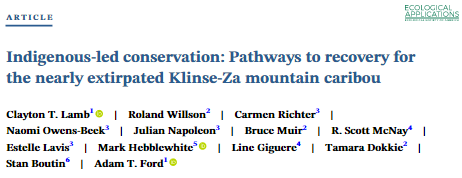Are you interested in indigenous lead conservation of fauna? Interested in recovery pathways for nearly extirpated species? Are you invested in the development of populations of Klinse-za mountain caribou?
Mountain Sentinel network partners Canadian Mountain Network (CMN) sponsored the authorship of a paper that sparks interesting discourse on the subjects above! If you are interested, check out the abstract below and the provided link to the paper.
Abstract
Indigenous Peoples around the northern hemisphere have long relied on caribou for subsistence and for ceremonial and community purposes. Unfortunately, despite recovery efforts by federal and provincial agencies, caribou are currently in decline in many areas across Canada. In response to recent and dramatic declines of mountain caribou populations within their traditional territory, West Moberly First Nations and Saulteau First Nations (collectively, the “Nations”) came together to create a new vision for caribou recovery on the lands they have long stewarded and shared. The Nations focused on the Klinse-Za subpopulation, which had once encompassed so many caribou that West Moberly Elders remarked that they were “like bugs on the landscape.” The Klinse-Za caribou declined from ~250 in the 1990s to only 38 in 2013, rendering Indigenous harvest of caribou nonviable and infringing on treaty rights to a subsistence livelihood. In collaboration with many groups and governments, this Indigenous-led conservation initiative paired short-term population recovery actions, predator reduction and maternal penning, with long-term habitat protection in an effort to create a self-sustaining caribou population. Here, we review these recovery actions and the promising evidence that the abundance of Klinse-Za caribou has more than doubled from 38 animals in 2013 to 101 in 2021, representing rapid population growth in response to recovery actions. With looming extirpation averted, the Nations focused efforts on securing a landmark conservation agreement in 2020 that protects caribou habitat over a 7986-km2 area. The Agreement provides habitat protection for >85% of the Klinse-Za subpopulation (up from only 1.8% protected pre-conservation agreement) and affords moderate protection for neighboring caribou subpopulations (29%–47% of subpopulation areas, up from 0%–20%). This Indigenous-led conservation initiative has set both the Indigenous and Canadian governments on the path to recover the Klinse-Za subpopulation and reinstate a culturally meaningful caribou hunt. This effort highlights how Indigenous governance and leadership can be the catalyst needed to establish meaningful conservation actions, enhance endangered species recovery, and honor cultural connections to now imperiled wildlife.

